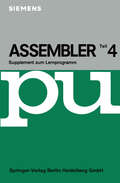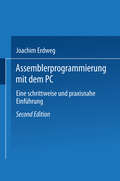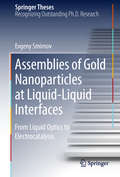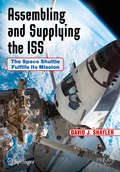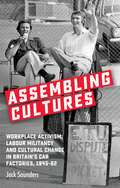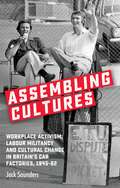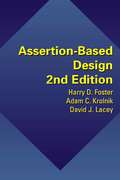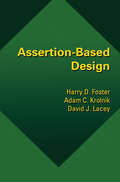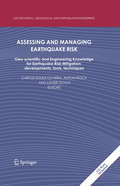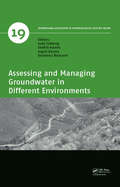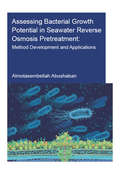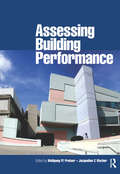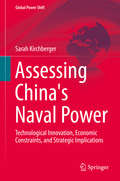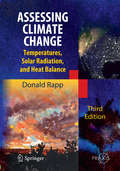- Table View
- List View
Assembled Lanthanide Complexes with Advanced Photophysical Properties (Springer Theses)
by Yuichi HiraiThis thesis provides essential information on the systematic design of assembled lanthanide complexes for functional luminescent materials. It discusses the relationships between assembled structures and photo, thermal, and mechanical properties on the basis of crystallography, spectroscopy, and thermodynamics. The described guidelines for assembled structures will be extremely valuable, both for industrial applications and for readers’ fundamental understanding of solid-state photophysics and materials chemistry. Luminescent lanthanide complexes are promising candidates for lighting devices, lasers, and bio-probes owing to their line-like and long-lived emission arising from characteristic 4f–4f transitions. Low-vibrational and asymmetrical coordination structures around lanthanide ions have been introduced to achieve strong luminescence, using specific organic ligands. Recently, assembled lanthanide complexes including coordination polymers and metal organic frameworks have increasingly attracted attention as a new class of luminescent materials offering thermal stability and color tunability. However, improving the luminescence efficiencies of these compounds remains a challenge, and specific molecular designs to control assembled structures and yield additional physical properties have not been established. The author provides a group of bent-angled bridging ligands to boost photoluminescence efficiency, and successfully introduces for the first time glass formability and strong triboluminescence properties.
Assembler: Hard- und Software für Mikrocontroller, Messtechnik, Anwendungen, Core-Technologie
by Herbert BernsteinIn diesem Fachbuch für Assemblerprogrammierung werden die erforderlichen Kenntnisse auf dem Gebiet der Hardware und Software in einander greifend erklärt. Es wird in zahlreichen Applikationen das Zusammenspiel der einzelnen Steuerbits und -worte anhand praktischer Anwendungen dargestellt.
Assembler griffbereit
by Joachim ErdwegDieses Buch der Reihe griffbereit stellt eine systematisch geordnete, nützliche Übersicht vor, die jedem Programmierer eine effektive Arbeitshilfe sein wird.Mit diesem Buch knüpft der Autor an sein erfolgreiches Assemblerbuch an, das ebenfalls im Verlag erschienen ist.
Assembler IV: Supplement zum Lernprogramm (Heidelberger Taschenbücher #189)
by H. KramerDie posItIve Aufnahme des Lernprogramms im Interessentenkreis gab den Anstoß, es durch Hinzufügen neuer Befehle und Anwendungsbeispie le zu erweitern. Damit werden vor allem den primär mit der Assembler sprache befaßten Programmierern in der kommerziellen Datenverarbei tung zusätzliche Arbeitshilfen geboten und neue Einsatzmöglichkeiten des Assemblers aufgezeigt. Da der erwartete Trend zur Anwendung von problemorientierten Pro grammiersprachen vor allem wegen der in jüngster Zeit hinzugekomme nen Aufgaben in der Datenfernverarbeitung nicht in dem erwarteten Umfang eingetreten ist, wächst der Bedarf an Assembler-Programmierern noch ständig an. Das vorliegende Komplement zum Lernprogramm trägt diesen Aspekten Rechnung und spiegelt damit auch die Tendenz wider, anlagenunabhängiges und standardisiertes Wissen sowie leicht erlernbare Formalismen weitestgehend in einer zeitgemäßen, dem Lerntempo des einzelnen angepaßten Form zu vermitteln. Die neue AufgabensteIlung hat dazu geführt, für den vorliegenden vierten Teil eine eigene Konzeption zu entwickeln, die sich von der der ersten drei Teile unterscheidet. Neben der Vermittlung weiterer Sprachelemente liegt das Hauptgewicht auf der Anwendung der Assemblersprache beim Lösen zahlreicher einfacher Aufgaben. Die Beispiele wurden so ausgewählt und erläutert, daß sie leicht nachzuvollziehen sind. Auf diese Weise soll der Lernende die Sicherheit gewinnen, die ihm als Anfänger den Weg in die berufliche Praxis erleichtert. Didaktische Überlegungen standen auch diesmal im Vordergrund bei der Auswahl und Darstellung der Assembler Sprachelemente. Den Abschluß des vierten Teils bildet ein Codierprakti kum, in dem man die erworbenen Kenntnisse an umfangreicheren AufgabensteIlungen erproben kann.
Assembler- Programmierung mit dem PC: Eine schrittweise und praxisnahe Einführung
by Joachim ErdwegDieses Buch ist eine praxisgerechte und leichtverständliche Einführung in die Assemblerprogrammierung.
Assemblies of Gold Nanoparticles at Liquid-Liquid Interfaces: From Liquid Optics to Electrocatalysis (Springer Theses)
by Evgeny SmirnovThis book is devoted to various aspects of self-assembly of gold nanoparticles at liquid-liquid interfaces and investigation of their properties. It covers primarily two large fields: (i) self-assembly of nanoparticles and optical properties of these assemblies; and (ii) the role of nanoparticles in redox electrocatalysis at liquid-liquid interfaces. The first part aroused from a long-lasting idea to manipulate adsorption of nanoparticles at liquid-liquid with an external electric field to form 'smart' mirrors and/or filters. Therefore, Chapters 3 to 5 are dedicated to explore fundamental aspects of charged nanoparticles self-assembly and to investigate optical properties (extinction and reflectance) in a through manner. Novel tetrathiafulvalene (TTF)-assisted method leads to self-assembly of nanoparticles into cm-scale nanofilms or, so-called, metal liquid-like droplets (MeLLDs) with remarkable optical properties. The second part (Chapters 6 to 8) clarifies the role of nanoparticles in interfacial electron transfer reactions. They demonstrate how nanoparticles are charged and discharged upon equilibration of Fermi levels with redox couples in solution and how it can be used to perform HER and ORR. Finally, Chapter 9 gives a perspective outlook, including applications of suggested methods in fast, one-step preparation of colloidosomes, SERS substrates as well as pioneer studies on so-called Marangony-type shutters drive by the electric field.
Assembling and Supplying the ISS: The Space Shuttle Fulfills Its Mission (Springer Praxis Books)
by David J. ShaylerThe creation and utilization of the International Space Station (ISS) is a milestone in space exploration. But without the Space Shuttle, it would have remained an impossible dream. Assembling and Supplying the ISS is the story of how, between 1998 and 2011, the Shuttle became the platform which enabled the construction and continued operation of the primary scientific research facility in Earth orbit. Fulfilling an objective it had been designed to complete decades before, 37 Shuttle missions carried the majority of the hardware needed to build the ISS and then acted as a ferry and supply train for early resident crews to the station. Building upon the decades of development and experience described in the companion volume Linking the Space Shuttle and Space Stations: Early Docking Technologies from Concept to Implementation, this book explores • a purpose-built hardware processing facility • challenging spacewalking objectives • extensive robotic operations • undocking a unmanned orbiter The experience and expertise gained through these missions allows space planners to improve space construction skills in advance of even more ambitious plans in the future.
Assembling cultures: Workplace activism, labour militancy and cultural change in Britain's car factories, 1945-82
by Jack SaundersAssembling cultures takes a fine-grained look at workplace activism in car manufacturing between 1945 and 1982, using it as a key case for unpicking narratives around affluence, declinism and class. It traces the development of the militant car worker stereotype, looking at the social relations which lay behind the industry’s reputation for conflict. This book reveals a changing, complex world of social practices, cultural norms, shared values and expectations. From the 1950s, car workers developed shop-floor organisations of considerable authority, enabling some new demands of their working lives, but constraining other more radical political aims. This is a story of workers and their place in the power relations of post-war Britain. This book is invaluable to academics and students studying the history, sociology and politics of modern Britain, particularly those with an interest in power, rationality, class, labour, gender and race.
Assembling cultures: Workplace activism, labour militancy and cultural change in Britain's car factories, 1945-82
by Jack SaundersAssembling cultures takes a fine-grained look at workplace activism in car manufacturing between 1945 and 1982, using it as a key case for unpicking narratives around affluence, declinism and class. It traces the development of the militant car worker stereotype, looking at the social relations which lay behind the industry’s reputation for conflict. This book reveals a changing, complex world of social practices, cultural norms, shared values and expectations. From the 1950s, car workers developed shop-floor organisations of considerable authority, enabling some new demands of their working lives, but constraining other more radical political aims. This is a story of workers and their place in the power relations of post-war Britain. This book is invaluable to academics and students studying the history, sociology and politics of modern Britain, particularly those with an interest in power, rationality, class, labour, gender and race.
Assembly and Reliability of Lead-Free Solder Joints
by John H. Lau Ning-Cheng LeeThis book focuses on the assembly and reliability of lead-free solder joints. Both the principles and engineering practice are addressed, with more weight placed on the latter. This is achieved by providing in-depth studies on a number of major topics such as solder joints in conventional and advanced packaging components, commonly used lead-free materials, soldering processes, advanced specialty flux designs, characterization of lead-free solder joints, reliability testing and data analyses, design for reliability, and failure analyses for lead-free solder joints. Uniquely, the content not only addresses electronic manufacturing services (EMS) on the second-level interconnects, but also packaging assembly on the first-level interconnects and the semiconductor back-end on the 3D IC integration interconnects. Thus, the book offers an indispensable resource for the complete food chain of electronics products.
Assembly Automation and Product Design (Manufacturing Engineering And Materials Processing Ser.)
by Geoffrey BoothroydAddressing design for automated and manual assembly processes, Assembly Automation and Product Design, Second Edition examines assembly automation in parallel with product design. The author enumerates the components, processes, performance, and comparative economics of several types of automatic assembly systems. He provides information on equipme
Assembly Line Balancing under Uncertain Task Time and Demand Volatility (Engineering Applications of Computational Methods #8)
by Yuchen LiThis book introduces several mathematical models in assembly line balancing based on stochastic programming and develops exact and heuristic methods to solve them. An assembly line system is a manufacturing process in which parts are added in sequence from workstation to workstation until the final assembly is produced. In an assembly line balancing problem, tasks belonging to different product models are allocated to workstations according to their processing times and precedence relationships among tasks. It incorporates two features, uncertain task times, and demand volatility, separately and simultaneously, into the conventional assembly line balancing model. A real-life case study related to the mask production during the COVID-19 pandemic is presented to illustrate the application of the proposed framework and methodology. The book is intended for graduate students who are interested in combinatorial optimizations in manufacturing with uncertain input.
Assembly Line Design: The Balancing of Mixed-Model Hybrid Assembly Lines with Genetic Algorithms (Springer Series in Advanced Manufacturing)
by Brahim Rekiek Alain DelchambreEfficient assembly line design is a problem of considerable industrial importance. Assembly Line Design will be bought by technical personnel working in design, planning and production departments in industry as well as managers in industry who want to learn more about concurrent engineering. This book will also be purchased by researchers and postgraduate students in mechanical, manufacturing or micro-engineering.
Assembly Line Planning and Control
by Nick T. ThomopoulosAssembly Line Planning and Control describes the basic fundamentals of assembly lines for single model lines, mixed model make-to-stock lines, mixed model make-to-order lines and for one-station assembly. The book shows how to select the quantity of units to schedule for a shift duration, compute the number of operators needed on a line, set the conveyor speed, coordinate the main line with sub-assembly lines, assign the work elements to the operators on the line, sequence the models down the line, sequence the jobs down the line, calculate the part and component requirements for a line and for each station, determine the replenish needs of the parts and components from the suppliers, compute the similarity between the models being produced and show applications, use learning curves to estimate time and costs of assembly, and measure the efficiency of the line. The material is timeless and the book will never become obsolete. The author presents solutions with easy-to-understand numerical examples that can be applied to real-life applications.
Assembly Processes: Finishing, Packaging, and Automation
by Richard CrowsonToday's fast-paced manufacturing culture demands a handbook that provides how-to, no-holds-barred, no-frills information. Completely revised and updated, the Handbook of Manufacturing Engineering is now presented in four volumes. Keeping the same general format as the first edition, this second edition not only provides more information but makes i
Assertion-Based Design
by Harry D. Foster Adam C. Krolnik David J. LaceyChapter 3 Specifying RTL Properties 61 3. 1 Definitions and concepts 62 62 3. 1. 1 Property 3. 1. 2 Events 65 3. 2 Property classification 65 Safety versus liveness 66 3. 2. 1 3. 2. 2 Constraint versus assertion 67 3. 2. 3 Declarative versus procedural 67 3. 3 RTL assertion specification techniques 68 RTL invariant assertions 69 3. 3. 1 3. 3. 2 Declaring properties with PSL 72 RTL cycle related assertions 73 3. 3. 3 3. 3. 4 PSL and default clock declaration 74 3. 3. 5 Specifying sequences 75 3. 3. 6 Specifying eventualities 80 3. 3. 7 PSL built-in functions 82 3. 4Pragma-based assertions 82 3. 5 SystemVerilog assertions 84 3. 5. 1 Immediate assertions 84 3. 5. 2Concurrent assertions 86 3. 5. 3 System functions 95 3. 6 PCI property specification example 96 3. 6. 1 PCI overview 96 3. 7 Summary 102 Chapter 4 PLI-Based Assertions 103 4. 1 Procedural assertions 104 4. 1. 1 A simple PLI assertion 105 4. 1. 2 Assertions within a simulation time slot 108 4. 1. 3 Assertions across simulation time slots 111 4. 1. 4 False firing across multiple time slots 116 4. 2 PLI-based assertion library 118 4. 2. 1 Assert quiescent state 119 4. 3 Summary 123 Chapter 5 Functional Coverage 125 5. 1 Verification approaches 126 5. 2 Understanding coverage 127 5. 2. 1 Controllability versus observability 128 5. 2.
Assertion-Based Design
by Harry D. Foster Adam C. Krolnik David J. LaceyThere is much excitement in the design and verification community about assertion-based design. The question is, who should study assertion-based design? The emphatic answer is, both design and verification engineers. What may be unintuitive to many design engineers is that adding assertions to RTL code will actually reduce design time, while better documenting design intent. Every design engineer should read this book! Design engineers that add assertions to their design will not only reduce the time needed to complete a design, they will also reduce the number of interruptions from verification engineers to answer questions about design intent and to address verification suite mistakes. With design assertions in place, the majority of the interruptions from verification engineers will be related to actual design problems and the error feedback provided will be more useful to help identify design flaws. A design engineer who does not add assertions to the RTL code will spend more time with verification engineers explaining the design functionality and intended interface requirements, knowledge that is needed by the verification engineer to complete the job of testing the design.
Assessing and Managing Earthquake Risk: Geo-scientific and Engineering Knowledge for Earthquake Risk Mitigation: developments, tools, techniques (Geotechnical, Geological and Earthquake Engineering #2)
by Carlos Sousa Oliveira Antoni Roca Xavier Goula* Multidisciplinary approach of risk assessment and management, which can provide more efficient earthquake mitigation.* Transfer of Geo-scientific and engineering knowledge to Civil Protection and insurance agents* Approaches and common practices directly related to the preparation of earthquake emergency plans* Illustrated examples of actual applications, including web sites * Case-studies and information on relevant international projects
Assessing and Managing Groundwater in Different Environments (IAH - Selected Papers on Hydrogeology)
by Jude Cobbing Shafick Adams Ingrid Dennis Kornelius RiemannThis collection of papers is a snapshot of modern hydrogeology in which highly technical methods and approaches sit side-by-side with overlapping legal, social, organisational, institutional and governance considerations. Groundwater is integral to many human and environmental systems. Indeed, there appears to be a growing realisation that some of the most pressing physical problems in the field of hydrogeology - over-abstraction, salinization or pollution - can only really be solved by taking a multi-disciplinary approach to the issues that takes all other related professions into account. Whilst a ‘technical’ solution may be readily deciphered, the larger challenge usually lies in the sustainably-funded and widely-accepted implementation of that measure. This book ranges from discussion and debate on the hot topic of hydraulic fracturing of wells or ‘fraccing’ for shale gas and its potential to disrupt groundwater systems, to the application of highly technical modelling procedures to help solve complex, real world problems. It is a window on the preoccupations of modern hydrogeologists and an insight into the way in which hydrogeological techniques and methods are being holistically adapted to address problems in the real world. This book is targeted at professional hydrogeologists, sociologists, experts in governance, law and policy as well as ecologists and other professionals that nowadays all sit alongside groundwater understanding. The book will also appeal to politicians, resource managers, regulators and others interested in sustainable water supply.
Assessing Bacterial Growth Potential in Seawater Reverse Osmosis Pretreatment: Method Development and Applications (IHE Delft PhD Thesis Series)
by Almotasembellah AbushabanSeawater desalination is increasingly being used as a means to augment freshwater supplies in regions with high water stress, and reverse osmosis is increasingly the technology of choice because of the low energy consumption. However, seawater reverse osmosis (SWRO) systems suffer from various types of fouling, which can increase energy consumption and the use of chemicals during SWRO operation. In practice, pre-treatment systems are put in place to reduce the particulate and biological fouling potential of SWRO feed water. However, simple, reliable and accurate methods to assess the extent to which biological fouling potential is reduced during pre-treatment are not available for seawater. This research developed a new method to measure bacterial growth potential (BGP) using the native bacterial consortium in seawater. New reagents to extract and detect ATP in microbial cells were specifically developed for seawater. The new lysis and detection reagents overcame the salt interference in seawater and allow low detection of total ATP, free ATP and microbial ATP in seawater. Incorporating a filtration step further increased the sensitivity of the method six fold, enabling ATP detection of ultra-low levels of microbial ATP in seawater. The newly developed ATP-based BGP method was applied to monitor and assess the pre-treatment of five full-scale seawater desalination plants around the world. A good correlation was observed between BGP measured in SWRO feed water and the pressure drop increase in the SWRO systems, suggesting the applicability of using the ATP-based BGP method as a biofouling indicator in SWRO. Furthermore, a safe level of BGP ( In the future, on-line monitoring of BGP in SWRO feed water may further reduce the consumption of chemicals and energy and improve the overall sustainability of seawater desalination by reverse osmosis.
Assessing Bacterial Growth Potential in Seawater Reverse Osmosis Pretreatment: Method Development and Applications (IHE Delft PhD Thesis Series)
by Almotasembellah AbushabanSeawater desalination is increasingly being used as a means to augment freshwater supplies in regions with high water stress, and reverse osmosis is increasingly the technology of choice because of the low energy consumption. However, seawater reverse osmosis (SWRO) systems suffer from various types of fouling, which can increase energy consumption and the use of chemicals during SWRO operation. In practice, pre-treatment systems are put in place to reduce the particulate and biological fouling potential of SWRO feed water. However, simple, reliable and accurate methods to assess the extent to which biological fouling potential is reduced during pre-treatment are not available for seawater. This research developed a new method to measure bacterial growth potential (BGP) using the native bacterial consortium in seawater. New reagents to extract and detect ATP in microbial cells were specifically developed for seawater. The new lysis and detection reagents overcame the salt interference in seawater and allow low detection of total ATP, free ATP and microbial ATP in seawater. Incorporating a filtration step further increased the sensitivity of the method six fold, enabling ATP detection of ultra-low levels of microbial ATP in seawater. The newly developed ATP-based BGP method was applied to monitor and assess the pre-treatment of five full-scale seawater desalination plants around the world. A good correlation was observed between BGP measured in SWRO feed water and the pressure drop increase in the SWRO systems, suggesting the applicability of using the ATP-based BGP method as a biofouling indicator in SWRO. Furthermore, a safe level of BGP ( In the future, on-line monitoring of BGP in SWRO feed water may further reduce the consumption of chemicals and energy and improve the overall sustainability of seawater desalination by reverse osmosis.
Assessing Building Performance
by Wolfgang Preiser Jacqueline VischerThe building performance evaluation (BPE) framework emphasizes an evaluative stance throughout the six phases of the building delivery and life cycle: (1) strategic planning/needs analysis; (2) program review; (3) design review; (4) post-construction evaluation/review; (5) post-occupancy evaluation; and, (6) facilities management review/adaptive reuse.The lessons learned from positive and negative building performance are fed into future building delivery cycles. The case studies illustrate how this basic methodology has been adapted to a range of cultural contexts, and indicates the positive results of building performance assessment in a wide range of situations.
Assessing Building Performance
by Wolfgang F.E. Preiser Jacqueline C. VischerThe building performance evaluation (BPE) framework emphasizes an evaluative stance throughout the six phases of the building delivery and life cycle: (1) strategic planning/needs analysis; (2) program review; (3) design review; (4) post-construction evaluation/review; (5) post-occupancy evaluation; and, (6) facilities management review/adaptive reuse.The lessons learned from positive and negative building performance are fed into future building delivery cycles. The case studies illustrate how this basic methodology has been adapted to a range of cultural contexts, and indicates the positive results of building performance assessment in a wide range of situations.
Assessing China's Naval Power: Technological Innovation, Economic Constraints, and Strategic Implications (Global Power Shift)
by Sarah KirchbergerThis book analyzes the rise of China’s naval power and its possible strategic consequences from a wide variety of perspectives – technological, economic, and geostrategic – while employing a historical-comparative approach throughout. Since naval development requires huge financial resources and mostly takes place within the context of transnational industrial partnerships, this study also consciously adopts an industry perspective. The systemic problems involved in warship production and the associated material, financial, technological, and political requirements currently remain overlooked aspects in the case of China.Drawing on first-hand working experience in the naval shipbuilding industry, the author provides transparent criteria for the evaluation of different naval technologies’ strategic value, which other researchers can draw upon as a basis for further research in such diverse fields as International Security Studies, Naval Warfare Studies, Chinese Studies, and International Relations.
Assessing Climate Change: Temperatures, Solar Radiation and Heat Balance (Springer Praxis Books)
by Donald RappThis updated and revised new edition of Assessing Climate Change deals with the full gamut of essential questions in relation to global warming and climate change, uniquely providing a balanced and impartial discussion of this controversial subject. It shows that most of what is “known”about the Sun, historical climates and projections for the future lacks foundation and leaves great room for doubt.Assessing Climate Change (3rd Edition) examines the credibility of the global climate models which accuse greenhouse gases of causing the temperature rise of the 20th century, and provides a better understanding of the uncertainties regarding what might lie ahead in the future. Carefully considering the “evidence” brought forward by both alarmists and skeptics, this book:• has been brought completely up to date to end 2013;• examines the measurements of near surface temperatureson Earth and how much we can rely on them;• includes hundreds of graphs showing the data;• compares the current global warming trend with past climate fluctuations;• provides a systematic review of climate change in nearly all of its aspects;• expands the discussion of potential impacts of global warming (from whatever cause);• includes nearly 1000 references specific to the climate literature.



